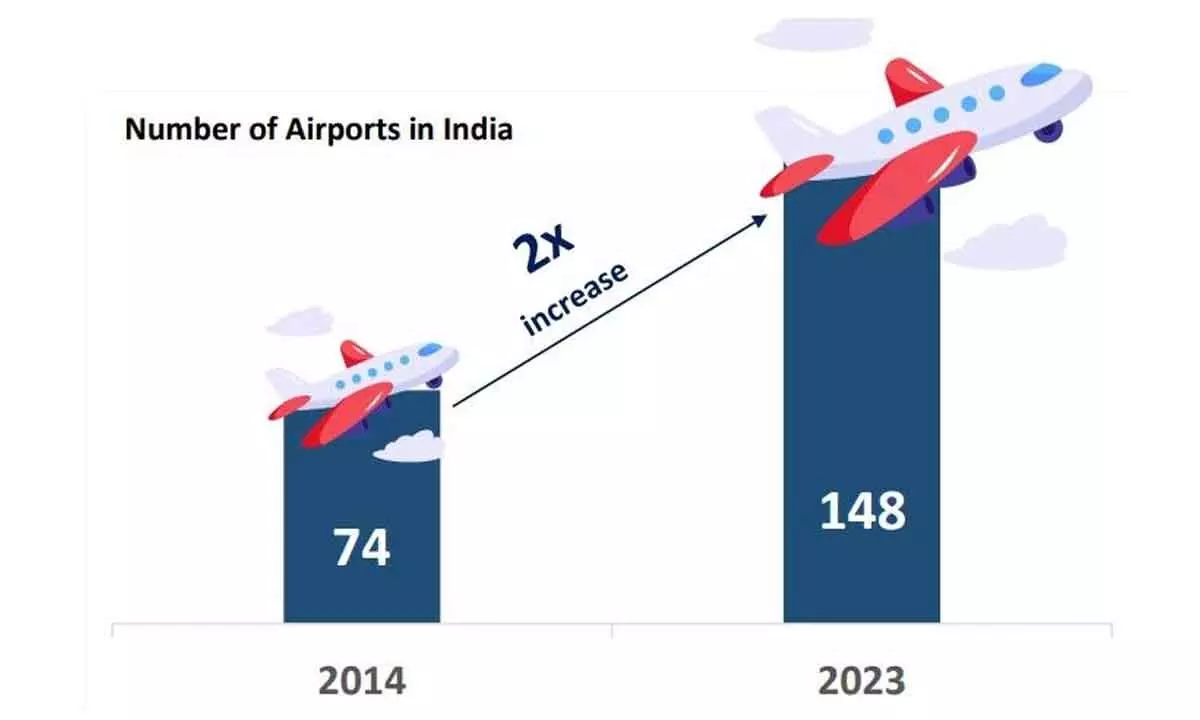The growth of airports reflects vibrancy of global businesses and tourism
Air transport is expected to increase by an annual average of 4.3 per cent
image for illustrative purpose

But the growing demand for air traffic also involves challenges, not least of which are the important logistical implications in and around airports to ensure the infrastructure is able to support this growth. The main question revolves around how we can achieve growth in a responsible and therefore sustainable way
Aviation provides the only worldwide transportation network, which makes it essential for global business and tourism. It plays a vital role in facilitating economic growth, particularly in developing countries.
India is expected to have at least 230 airports by 2030. The Union government has invested more than $11 billion in airports over the past decade and nearly doubled the number of airports during this period.
According to ICAO, aviation provides the only worldwide transportation network, which makes it essential for global business and tourism. It plays a vital role in facilitating economic growth, particularly in developing countries. The industry transports close to two billion passengers annually and 40% of interregional exports of goods (by value).
The air transport industry generates 29 million jobs globally (through direct, indirect, induced and catalytic impacts). Aviation’s global economic impact (direct, indirect, induced and catalytic) is estimated at $ 2,960 billion, equivalent to 8% of the world’s Gross Domestic Product (GDP).
The world’s 900 airlines have a total fleet of nearly 22,000 aircraft, which serve around 1,670 airports through a route network of several million km, managed by around 160 air navigation service providers.
Air transport entirely covers its infrastructure costs. Unlike road and rail, it is a net contributor to the national treasuries by way of taxes.
The aviation sector is growing fast and will continue to grow. The most recent estimates suggest that demand for air transport will increase by an average of 4.3% per annum over the next 20 years.
If this growth path is achieved by 2036, the air transport industry will then contribute 15.5 million in direct jobs and $1.5 trillion of GDP to the world economy. Once the impacts of global tourism are taken into account, these numbers could rise to 97.8 million jobs and $5.7 trillion in GDP.
Covid-19 has hit regional airports hard, especially those more dependent on passenger traffic, which has been more severely hit than cargo traffic. The situation is so difficult that without government support, many regional airports, which serve local communities, face the risk of insolvency. The pandemic has put airports under pressure to become digital, while a greater focus on tackling climate change is driving various projects to make them sustainable. The recovery from the pandemic crisis is likely to take several years. The speed with which the economy recovers will determine how long the recovery of air travel will take. All this requires support.
Airports cannot promote the economic growth of cities in remote or poor areas, but they could play an important role in promoting the economy of cities with high-level tourism resources and a strong industry foundation. Airports promote urban economy by increasing comprehensive transportation capacity, improving the market accessibility for enterprises in small and medium-sized cities.
Firm-level micro-evidence suggests that airports can shorten the temporal and spatial distances between cities, which significantly increases the productivity, sales, output, exports, and investment scale of industrial firms. Airports promote the economic growth of small and medium-sized cities by enhancing the economic vitality of micro-firms.
But the growing demand for air traffic also involves challenges, not least of which are the important logistical implications in and around airports to ensure the infrastructure is able to support this growth.
The main question revolves around how we can achieve growth in a responsible and therefore sustainable way.
As the industry plans to support a near doubling of passenger and cargo numbers by 2036, demand for pilots, engineers, air traffic controllers and other aviation-related jobs is expected to rise dramatically. What is also certain is that innovations in technology and approaches will be needed to sustain this growth.
Worldwide 51% of the population lives within 100 km of an international airport – and 74% within 100 km of any kind of airport. So airspace is quickly becoming congested and air traffic is slated to double over the next two decades.
In addition to air space – we have to consider airports themselves. Airports are already built up around population centres and operating at high capacity. The reality is that – in order to accommodate the forecast growth - drastic improvements and efficiencies for airports and air traffic management will need to be found. For this – we need innovation.
Aviation is already known as a driving force of global technology development and innovations.

